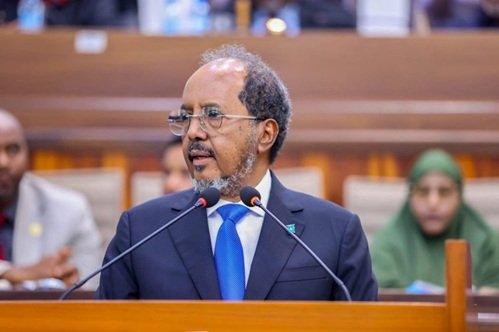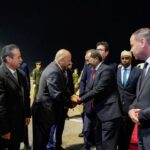By Abdiqani Haji Abdi
On a crisp Saturday morning, February 22, 2025, anticipation filled the air as Somalia’s parliament convened for the opening of its sixth session. All eyes turned to the podium as the president prepared to address the nation. Many hoped for clarity, solutions, and a vision that could guide the country out of its current turmoil. What followed, however, was a speech that echoed with hollow rhetoric—an elaborate display of words devoid of meaning.
Instead of addressing the pressing national issues, the president delved into grandiose ideas—satellite launch pads, the blue economy, offshore oil drilling—without acknowledging the devastating environmental and security risks these ventures pose to Somalia. His words painted a picture of progress, but to the ordinary Somali citizen, struggling under the weight of economic hardship and political instability, they rang hollow. It became evident that the president lived in a different reality, detached from the suffering and concerns of the people he was meant to lead.
A Deafening Silence on Election Manipulations
Among the most glaring omissions from his speech was the unconstitutional interference in federal member state (FMS) elections. Three regional leaders- South West, Hirshabeelle and Galmudug states, had been illegally prevented from conducting their elections—an unprecedented violation of Somalia’s provisional constitution. The president chose not to acknowledge this breach of democratic norms, offering no reassurances on how the rule of law would be restored or how he intended to prevent further political instability. His silence spoke volumes, signaling an intent to maintain control at any cost.
Jubaland Under Siege
In Jubaland, a constitutional election had taken place—one that should have been celebrated as a triumph of regional governance. Instead, the administration responded with hostility, launching military operations in Ras Kamboni, Dollow, and Bardheere while imposing suffocating economic and air travel restrictions.
These measures, ostensibly designed to punish the regional leadership, disproportionately affected ordinary citizens. The aviation blockade barred commercial flights, preventing sick patients from seeking medical treatment and severing crucial trade routes. Yet, curiously, one category of flights remained untouched: those carrying miraa, the narcotic leaf imported from Kenya. As reports surfaced of companies linked to the president’s inner circle profiting from this trade—charging an exorbitant $4.5 per kilogram in taxation at Jomo Kenyatta Airport—it became clear that the blockade was not about security but about personal financial gain.
Politicizing Diplomatic Protocols
Another major controversy ignored by the president was the denial of a diplomatic visa for former Prime Minister Mohamed Hussein Roble. The Somali Foreign Ministry, allegedly acting under direct presidential orders, blocked Roble’s request, violating standard diplomatic protocols. The former prime minister responded with dignity, remarking, “The man who threw sand at you did not harm you, but he revealed what was in his heart. What I refused to accept from my brother, President Farmaajo, I will not accept from President Hassan either.”
The move was widely condemned as an act of political vengeance, a dangerous precedent that could be weaponized against any opposition figure. Speculation grew that former Prime Minister Hassan Ali Khaire, another potential presidential contender, might soon face similar retribution.
Puntland economic strangulation
For four years, Puntland had been subjected to deliberate neglect. Development projects were withheld, federal resources redirected elsewhere, and security threats ignored. The ongoing battle against ISIS in Puntland—a war that posed an existential threat to Somalia’s stability—was met with indifference from the federal government.
It was only when Puntland’s forces, bolstered by their international partnerships, began making significant gains against ISIS that the president broke his silence. “I will soon appoint a support committee to deliver urgent aid to the righteous forces fighting in Puntland and other areas where battles are ongoing against the Khawarij of ISIS and Al-Shabaab,” he declared.
But Puntland’s leaders and citizens knew better. The sudden expression of support was not an act of solidarity but a calculated move to claim credit for a victory he had done nothing to achieve. If he was truly committed to supporting Puntland, why had he not lifted the four-year economic strangulation imposed on the region? Why had he not provided assistance when the fight against ISIS first escalated?
Corruption, Nepotism, and the Collapse of Governance
Under his administration, corruption had reached unprecedented levels. Unlike his predecessors, who at least maintained a semblance of institutional integrity, this president had been accused of financial misdeeds in both of his terms. Nepotism ran rampant—government appointments, ambassadorial posts, and high-ranking civil servant positions were no longer determined by merit but by clan affiliation and personal loyalty.
Parliament, once a check on executive overreach, had been reduced to a rubber-stamp body. Laws were passed without debate, agreements signed without scrutiny, and constitutional amendments made without consultation. Somalia had effectively become a one-man state, where all decisions—economic, political, and security-related—were dictated by a single individual.
The ‘Away’ President
Unlike his predecessors, who remained in the country to focus on governance, this president seemed more comfortable abroad. Whether it was summits meant for heads of state or minor conferences where mid-level officials could have sufficed, he was always traveling. His absence from Somalia’s pressing issues earned him the moniker ‘The Away President,’ as he appeared more engaged with foreign affairs than with the dire realities at home.
Mogadishu’s Financial System Hijacked
Perhaps the most brazen act of financial exploitation under his leadership was the outsourcing of Mogadishu’s inland revenue collection to private companies linked to his inner circle. These firms had effectively hijacked the city’s taxation system, diverting millions into their pockets while depriving the national treasury of much-needed funds.
Even more troubling, these companies did not use the official receipt books issued by the Accountant General. Instead, they provided unregistered receipts, making it impossible to track actual revenue. The Ministry of Finance’s inland revenue collection department, whose sole purpose was to manage tax collection, continued receiving salaries—despite being rendered functionally obsolete by this corrupt arrangement.
Economic Collapse and Security Failures
The Somali economy was in freefall. Inflation soared, making basic necessities unaffordable for ordinary citizens. Corruption at the highest levels exacerbated the crisis, with public funds vanishing into private accounts. The president’s speech offered no solutions—no roadmap for economic recovery, no plan to alleviate the suffering of millions.
Meanwhile, Al-Shabaab continued to expand its territory. The national army, weakened by corruption in the logistics chain, struggled to mount a proper defense. Soldiers, though officially receiving salaries, often went without food and basic supplies as corrupt intermediaries siphoned off military funds. The president, instead of presenting a security strategy, chose to ignore these glaring failures altogether.
A Looming Threat
The president’s speech exposed a leader disconnected from the realities on the ground. His inaction and misgovernance were not just administrative failures but existential threats to Somalia’s future. If the government continued down this path, it was only a matter of time before Al-Shabaab exploited the growing vacuum. Corruption, economic collapse, and political instability were creating the perfect storm for extremism to thrive.
Somalia had been here before. The warning signs were clear. And yet, those in power refused to heed them. If change did not come soon, the country would face consequences far graver than anyone dared to imagine.
Abdiqani Haji Abdi
Email: [email protected]














